Stop 7: The Steeg and Wertheim Families
Düsseldorfer Str. 35 – go to map – go to starting point
Paul Steeg was born in Bochum on 6 May 1874 and was the son of merchant Louis Steeg and his wife Sara. Paul’s wife-to-be, Emma Steinberg, was born in Castrop on 20 June 1875. The couple got married in August 1904. In Ohligs, they lived at Düsseldorfer Str. 31 at first which is also where they opened the first store of their own. In 1909, the “Central-Bazar Paul Steeg”, as the business was called, moved to Düsseldorfer Straße 35 where it was henceforth located in the distinctive corner house of Heinrich Pongs, a merchant dealing with manufactured goods.

Their business’ foundation phase was successful: the amount of taxes that Paul Steeg had to pay quadrupled between 1906 and 1907. In the years that followed, the “Central-Bazar” continuously belonged to the largest Jewish businesses in Ohligs. The store’s range of products included toys, wicker furniture, household appliances, art objects, smaller items of furniture, giftware as well as goods made from leather, nickel or crystal.

On 30 June 1905, Emma Steeg gave birth to daughter Grete. On 27 June 1907, Paul Steeg placed an employment notice in the weekly “Der Israelit”, the [in translation] “Central Organ for Orthodox Judaism”. It read [in translation]:
“Looking for an older, hardworking girl that can support my wife. Should have run a middle-class household before and be able to cook perfectly. Domestic staff includes a maid. Please direct applications incl. photograph and salary requirements to Paul Steeg, Ohligs close to Solingen.”
Job listing in “Der Israelit” of 27 June 1907. Source: University Library in Frankfurt on the Main, Compact Memory (translation: M.B., 2021)
Between 1915 and 1922, daughter Grete attended the “Lyzeum” (secondary school for girls) in Ohligs. She was trained as merchant at her parents’ store after that and, from 1928 onwards, worked as bookkeeper in the family business. She got engaged to merchant Albert Oster in December 1926, but eventually married merchant Walter Wertheim in 1929. Walter had been born in Iserlohn on 14 August 1899. After the wedding, Grete was in charge of purchasing and selling at the company “H. Wertheim Nachf.” (literally “H. Wertheim Descendants”) in Iserlohn and Hemer at first. In June 1931, she and her husband moved to Ohligs.

In June 1931, Paul Steeg announced and advertised the clearance sale of his goods. The Steegs’ department store was about to undergo conversion. In August 1931, Paul’s son-in-law Walter Wertheim, manager of “ERWEGE Einheitspreis-GmbH” (literally “ERWEGE Unit Price Ltd.”) had that company be entered in the commercial registry. “ERWEGE” stands for “Einkaufsgenossenschaft Rheinisch-Westfälischer Geschäftshäuser” (literally “Purchasing Association of Rhenish-Westphalian Commercial Firms”) and was a union of independent retailers. Its aim was to guarantee the discounted purchase of goods.
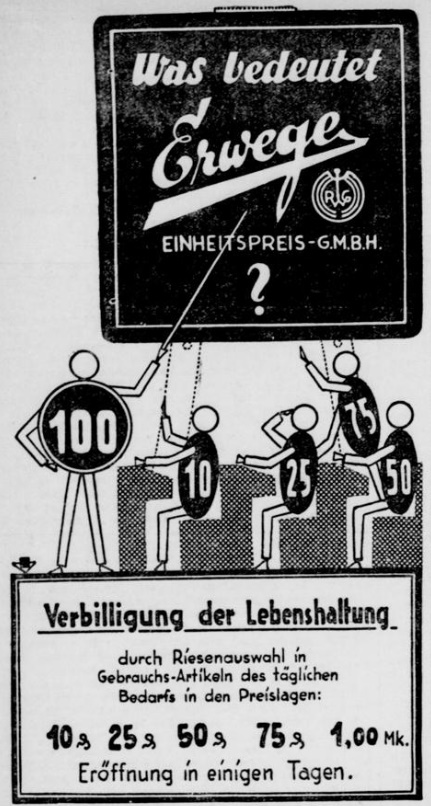
The new department store was opened on 9 September 1931 and sold goods at small prices. In the next few years, it would count between 45 and 60 employees at a time. 40% of the generated profits went to Paul Steeg. From 1931 onwards, he was the deputy representative of Solingen’s synagogue community. From 1937 until his death, he also was its deputy provost.
At first, the Wertheims’ business was commercially very successful. Former employees remember Walter Wertheim as a strict but fine boss who always had a sympathetic ear for his staff and their personal problems. Grete was responsible for the employees and managed the departments for textile goods, leatherware, stationery and footwear.
Business was going well even after the National Socialists started implementing their boycott measures from 1933 onwards. The company was rebranded in 1933 and henceforth operated under the name of “Walter Wertheim GmbH”. Walter’s younger brother Fritz Wertheim moved to Ohligs in August 1933. He had studied law in Marburg and Würzburg, among other cities, and had completed his studies with a doctorate in 1932. However, after the Nazis’ seizure of power, Fritz was crossed out from the register of lawyers on 1 April 1933 and, as a consequence, lost the law office he was in the process of setting up.
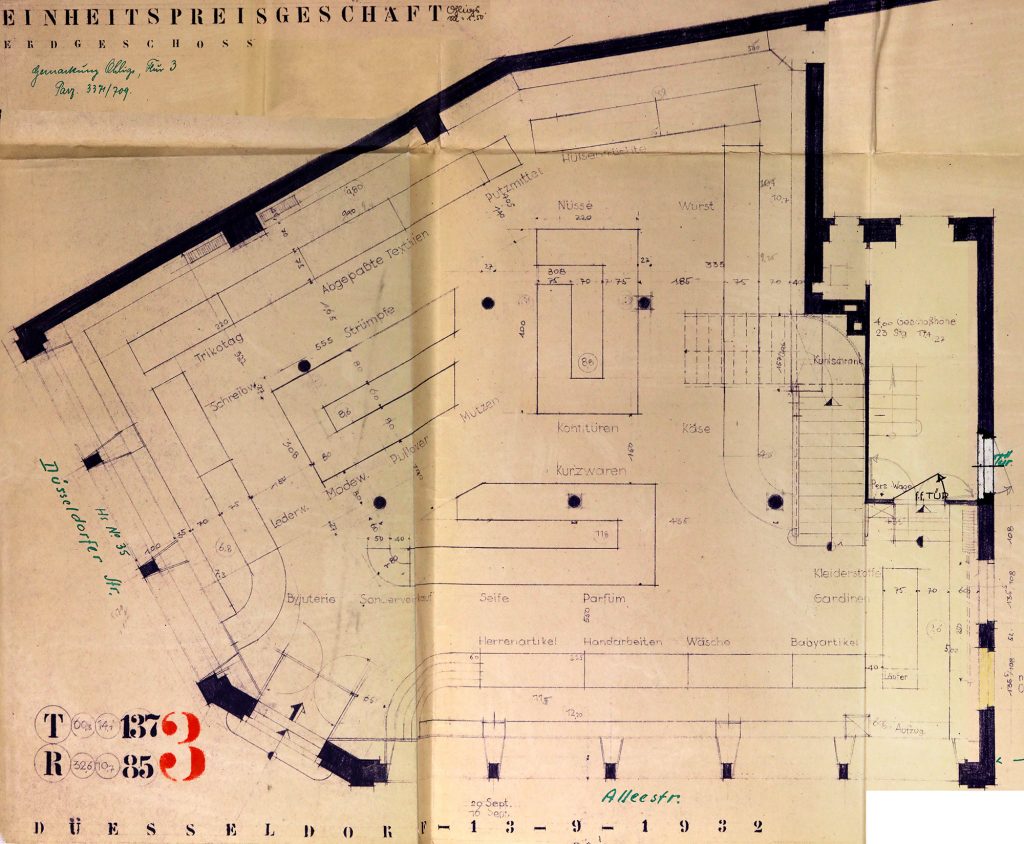
Thereupon, Fritz joined the “ERWEGE” as apprentice; later on, he would become its general manager. As for his private life, Fritz Wertheim was active in the “Sportbund ‘Schild‘ des Reichsbunds jüdischer Frontsoldaten” (literally “Sports Association ‘Shield’ of the Reich Federation of Jewish Front-Line Soldiers”) in Düsseldorf – as was, presumably, his brother Walter. The association tried to keep sporting activities possible for Jews despite the conditions during the Nazi dictatorship.
Although its owners became increasingly discriminated and disenfranchised, the Wertheim department store managed to make profits until 1937. However, when Walter Wertheim visited his friend Kurt Mark in New York during the summer of 1936, he was probably already contemplating emigration. And yet, the company was still advertising in the “Central-Verein-Zeitung” of 3 November 1938. The “Central-Verein-Zeitung” was a weekly newspaper published by the “Central-Verein deutscher Staatsbürger jüdischen Glaubens” (literally “Central Association of German Citizens of Jewish Faith”). Only a few days later, the store was completely demolished during the “Kristallnacht”, as were the private apartments of the Steeg and Wertheim families. After the war, Albert Drees, former stockman at the company, testified [in translation]:
“That night, when the so-called Jew action was happening, Dr. Wertheim called me to the store at Düsseldorferstraße. When I arrived, the shop windows had already been smashed. Together with two other employees and the Wertheim brothers, we immediately started to clear up the place. Shortly afterwards, a number of SA men in uniforms arrived and, led by Sturmführer Eschenbrücher, they forcefully re-entered the store once again and demolished the interior furnishing. We fled to the private apartment of the Steeg family. Since things were getting dangerous, the Wertheim family then made it outside through a bathroom window. After fetching some clothes from their flat at Marktstraße, they fled towards Düsseldorf. Mrs. Steeg stayed with us. The offenders then forced an entry to the private apartment of the Steeg couple and created havoc there. They did not lay hands on Mrs. Steeg. […] I don’t want to leave unmentioned that Oberleutnant Dreyer, at the time head of the local police station, […] said to me: ‘A German man does not work for Jews.’”
Testimony of Albert Drees (8 November 1946) on the destruction of the Wertheim department store (translation: M.B., 2021). Source of the German text: LAV R NRW Gerichte Rep. 191, Nr. 43, Bl. 3, as quoted in Stracke, Stephan: Der Novemberpogrom 1938 in Solingen im Spiegel der Justiz. Darstellungen und Dokumente, Solingen: 2018, p. 155
Emma Steeg fled to Cologne at first where her husband Paul was a patient at the “Israelite Asylum” – the former Jewish hospital – at the time. Two days after the “Kristallnacht”, Paul died as a result of a peptic ulcer on 11 November 1938. It is uncertain whether his daughter and son-in-law also had the chance to say farewell to Paul at the asylum. On 12 November 1938 already, Grete and Walter Wertheim, joined by Walter’s brother Fritz, went aboard the S.S. Veendam in Rotterdam. The ship reached the harbour of New York on 23 November.



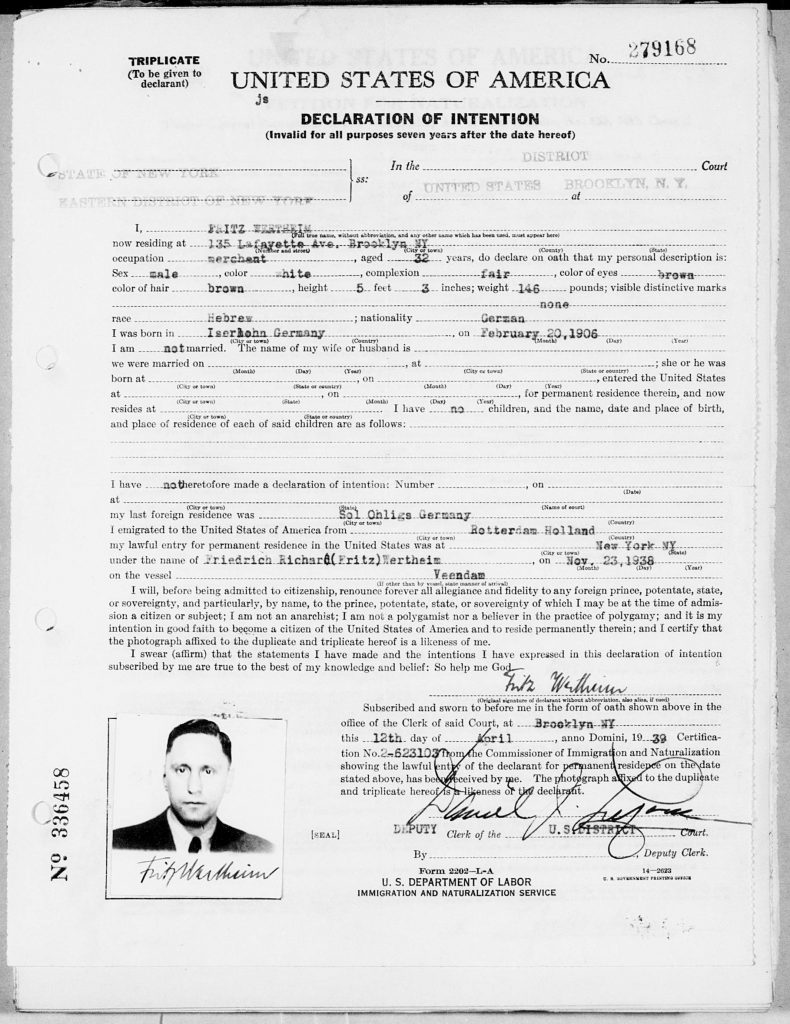
In Ohligs, business operations of the Wertheim store were discontinued. The clearing work was organised by a provisional manager that the Nazi Party NSDAP had appointed. The company was “Aryanised”, meaning it was transferred to a non-Jewish owner. The furniture from the Steeg and Wertheim households was also sold off.
On 8 December 1939, when the war had already started, Emma Steeg finally managed to follow her daughter to New York. She also travelled aboard the S.S. Veendam from Rotterdam and reached New York on 22 December.
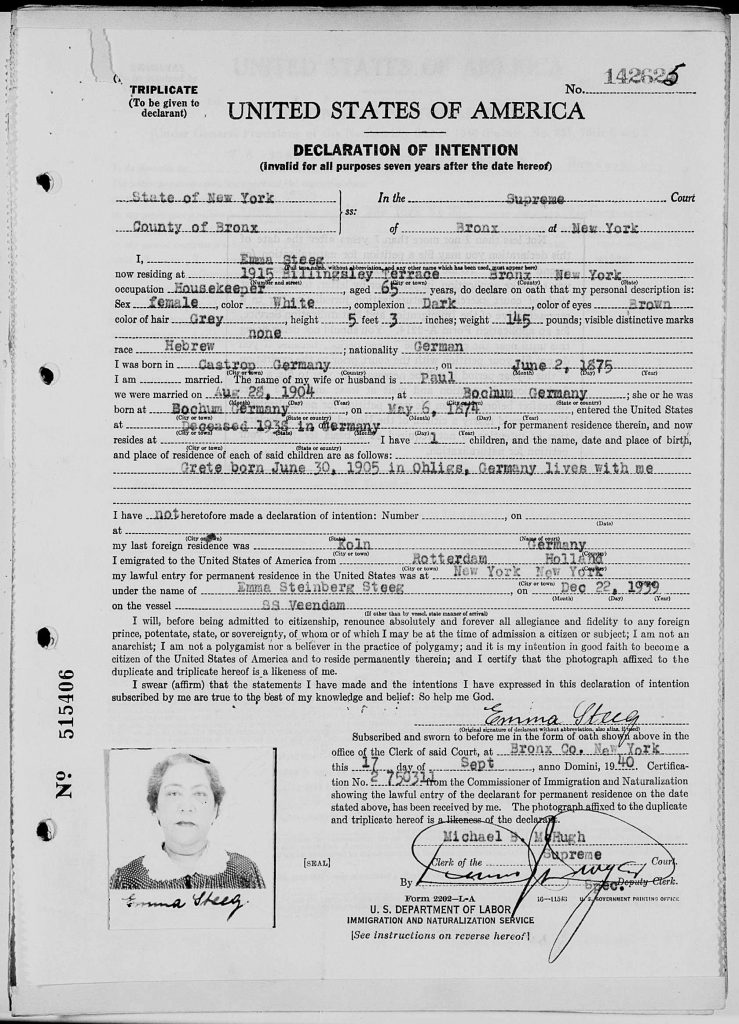
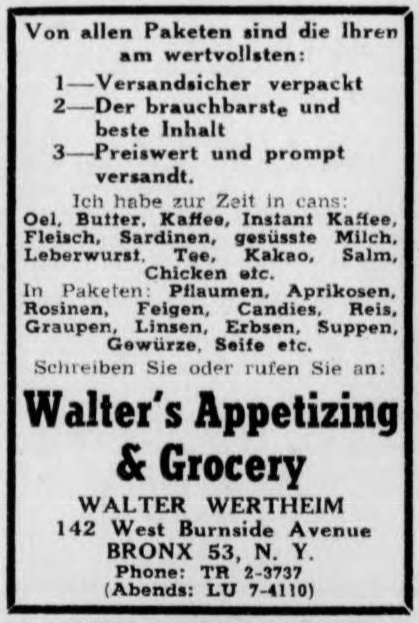
In New York, Walter Wertheim kept doing different occasional jobs until, in November 1939, he was able to acquire a grocery store. In an issue of the New Yorker periodical “Aufbau” from December 1946, he advertised “Walter’s Appetizing & Grocery”. His business was located in the Bronx. During those years, the herring salad prepared from one of Emma Steeg’s recipes was an absolute best seller. Walter and Grete always congratulated Emma on her milestone birthdays via announcements in the “Aufbau”. Emma died in New York on 22 February 1959. Fritz Wertheim, who had adopted the name of Fred by then, passed away in New York on 18 October 1980.
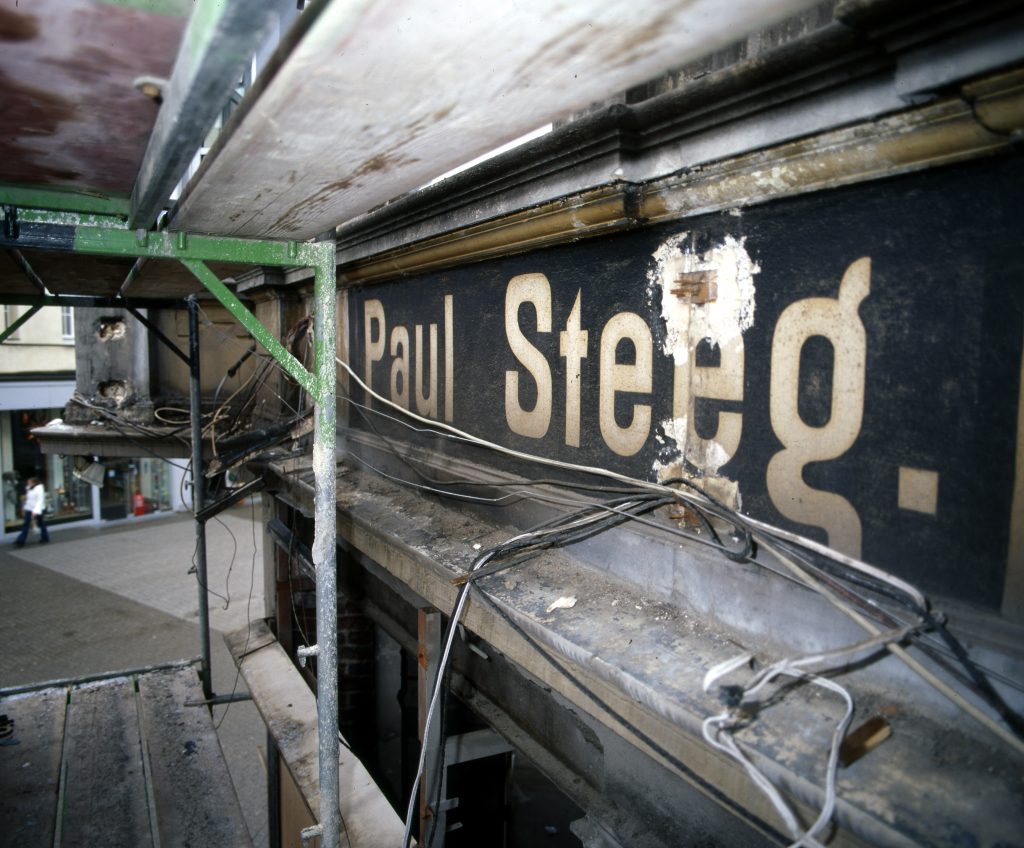
Throughout the 1980s, former employees of the department store gathered in Ohligs on a regular basis and kept in touch with Walter and Grete Wertheim via telephone. They jointly congratulated the couple on their diamond wedding in 1989. Walter Wertheim died in New York on 1 August 1991, his wife Grete passed away only a couple of days later, on 8 August.
